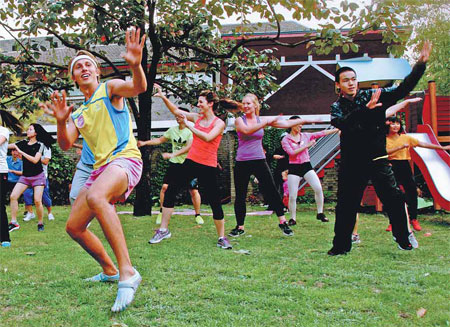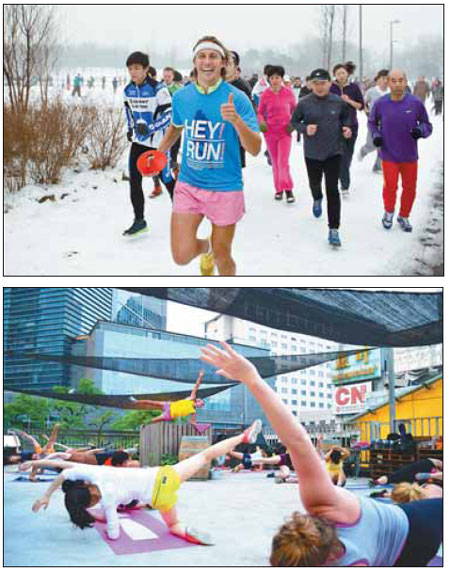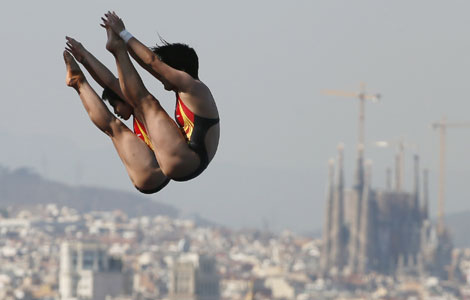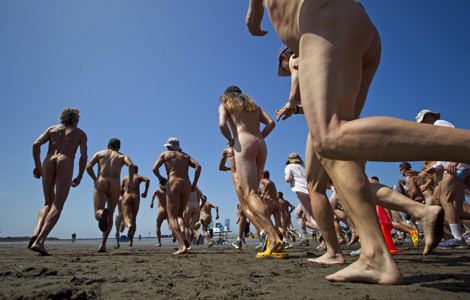Swede ambitions
Updated: 2013-07-23 07:20
By Tang Zhe (China Daily)
|
||||||||
|
Linus Holmsater leads a Heyrobics session at the Swedish embassy in 2012. Photos Provided to China Daily |
|
From top: Holmsater puts on a shirt and shorts to promote Heyrobics at a snowfield cross country running event held in Beijing. He leads a rooftop workout at the Bookworm in Beijing. |

He thinks the Chinese work too hard and the long hours will ultimately take a toll on their health. He wants to give them a chance at a better, healthier lifestyle and shares his vision with Tang Zhe.
When Linus Holmsater first came to Beijing in 2009, he was confounded by the daily routine of the Chinese around him.
Unlike his home country Sweden where almost every young person would exercise, and where he is never more than a 15-minute bike ride from the natural forests, Chinese cities have few parks, and the people tend to spend most of their time sitting behind their desks at work or sitting behind dinner tables or in a KTV room.
"In Sweden few people work overtime, but China is the opposite. People are very focused on their careers, they work long hours," Holmsater says. "After work, most of the socializing is done around a dinner table. If this goes on for long, there will be a big health problem in China."
Holmsater quit his investment company job in 2011 in Beijing and has started to promote Heyrobics, a popular Swedish aerobics exercise created by his father Johan Holmsater in 1978.
"I didn't have time to do exercises, and I really needed some time to break away from that," says the 28-year-old. "I think everyone needs a third space beyond office and home. For some it could be a ballet studio or a private club, and we are making ourselves that third space for a lot of people to relax and have fun."
According to Holmsater, his father used to be a pentathlon athlete and was trying to get into the Olympics until a bad back ended his ambitions. The senior Holmsater was told by his doctor to rest, but the situation got worse after two years.
"When he retired from that kind of sport, he couldn't even walk," Holmsater says. "It was really bad, so he started to create some exercises he could do as rehabilitation."
As the senior Holmsater felt himself becoming stronger, he put music together with the movements and invited friends to join him. The sport then grew popular first in universities, and then all over Sweden.
"It is the biggest sport in Sweden today. About 6 percent of Swedish citizens are members of the Heyrobics association," Holmsater says.
After shedding his business suits, Holmsater put on a bright yellow shirt and pink shorts to promote Heyrobics in parks, music festivals and other suitable occasions. He is also found in marathons and running activities around the country, where he leads Heyrobics as warm-up exercises.
"Yellow is the Swedish color, and the pink shorts means we are not taking ourselves so seriously," says Holmsater, who always greets people with a cheerful "hey", a wide smile and a hearty high-five.
There were few participants in Beijing initially, with most of them foreigners, Within two years, however, the team has expanded to about 30 instructors, who hold nearly 30 classes a week in the capital city. They now have centers from Chaoyang Park to Sanlitun to the Beijing suburbs.
The bigger classes are at the Workers' Stadium and attract more than a hundred participants. About half the students are Chinese.
"I think there are about 2,500 people doing Heyrobics in Beijing today," Holmsater says.
He believes the sport's attraction comes from its welcoming attitude, easy for both the wallet and the mind. The fee participants pay is used to cover venue charges.
There are also some free sessions.
"The problem in China today is that gyms are very expensive, and we are trying to make exercise as cheap as possible so everyone can afford to join," says Holmsater, saying his challenge is to attract people who are sedentary rather than to compete with the gyms for business.
"We try to tell people it's OK, if you feel you can't do the movements, you can take a rest. If you feel something is complicated, we don't say it's wrong, but you can do it your own way, and we'll still like it.
"I think that's why we attract so many people who don't normally like exercising. We talk about the soul, and the body will come with the soul," he says.
Li Min, a sport enthusiast who used to practice yoga, hip-hop and taekwondo, has turned into a fervent fan of Heyrobics.
"It requires no basics, everybody dances with the music. Each session is designed to comply with how the human body works and it totally frees me from any pressure," Li says. "My colleagues always says I am now more energetic even when I work extra hours."
She also highlights the special charm of Heyrobics classes, in that they always serve as occasions for cultural exchange and making friends.
With more than 60 variations in Sweden, Heyrobics is an exercise for all age groups - each person can find an exercise to suit them. With the "hey" frenzy growing, the team is introducing more variations into China.
There are now eight versions in Beijing, and bar workouts were introduced recently, scheduled once a month in a bar, with DJ playing popular beats and Heyrobics instructors leading the exercises.
Holmsater also plans to start Heyrobics in Shanghai in September, and then on to more cities in the west and south.
"My ambition is to make Heyrobics easy for everyone to start no matter if he is in big cities or a small city of 5,000 people," Holmsater says.
Find more heyrobics schedule on
www.heyrobics.com.
Contact the writer at tangzhe@chinadaily.com.cn.
(China Daily USA 07/23/2013 page8)
Most Viewed
Editor's Picks

|

|

|
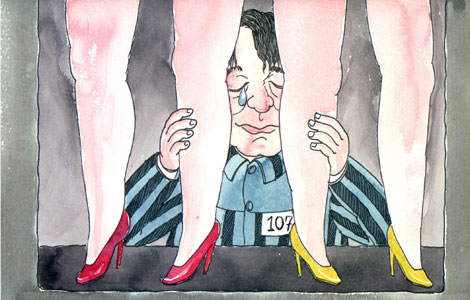
|

|

|
Today's Top News
Germany to probe spy services' ties with US
Snowden hopes to leave airport by Wednesday
Quake in NW China kills 89, injures 700
US blacks, whites split on Zimmerman verdict: poll
Kissinger and Jiang see bright future for relations
China sees no major forex withdrawal: regulator
Business holds up for Minmetals arm
Beijing knife attack leaves one dead
US Weekly

|

|
